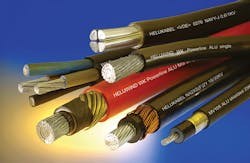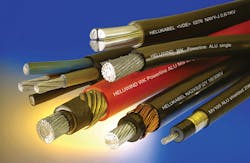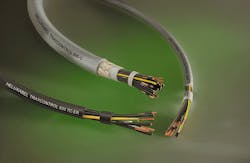What’s the Difference Between Aluminum and Copper in Electrical Applications?
This file type includes high-resolution graphics and schematics when applicable.
There are obviously materials property differences, such as, capacity, weight, and cost between aluminum (Al) and copper (Cu) to consider for an electrical application. Al was more prevalent in the past for products such as bus bars, fuses, and breakers. Overtime, some designers have changed components from Al to Cu. Today, due to cost stability and coating some designers are switching back.
Materials
Misconceptions about the properties between Al and Cu can arise due to different grades of metals used in different electrical applications. The Cu used in wire and electrical equipment is nominally pure. Pure Al, however, is often not strong enough for electrical applications. Also, keep in mind that different alloys have changed over time and on account of evolving applications.
Different Al alloy properties will also change, depending on processing. For example, Al 6101 is stronger than Al 1350. Yet heat-treating Al6101 hardens it and improves its strength. Different grades of metals, such as Al 6101 and Al 1350, will vary in comparisons with Cu. During the design process, it is therefore essential to have the material properties for the specific material used.
Properties
Weight, electrical capacity, and cost are major considerations when selecting Al or Cu for an electrical application. Yet others can loom just as large. For example, resistance in electrical connectors can increase if a material’s strength and expansion are not considered. As a connection undergoes thermal cycles, the expansion can increase the clamping force that can deform contact points and promote creep in materials. This will be a larger concern with Al because its coefficient of thermal expansion, depending on the alloy, is about 42% greater than Cu, but Al may be able to dissipate the heat faster.
Taking advantage of the lower modulus of elasticity since the 1990s, extruded Al bus bars have increased the surface area, helping to keep temperatures low. It is important when designing in either material that connections are robust to prevent poor connectivity over time, owing to deformation from thermal expansion, as well as creep.
A common misconception is that Al is soft and must use compression connectors. However, with some design and plating changes, mechanical pressure connectors and compression connectors are no longer required. In some cases, alloys or processing are used to make aluminum almost on par with Cu. Al can require coating to reduce oxidation in general as this can affect the connection – even an Al to Al connection. In addition, coating and plating often include tin or silver. These materials reduce corrosion in both Al and Cu, as they are prone to oxidation when exposed to the atmosphere.
Corrosion is also a problem when there are two dissimilar metals in one system. Al will electrochemically react with the Cu if moisture is introduced (moisture that would act as an electrolyte). Al to Cu cable lugs are connectors that have been friction welded and capsulated to prevent corrosion from damaging an Al-to-Cu connection. Proper connections are important, as corrosive wear is also a concern. Al and Cu are compatible metals, so contact can create bonding that can promote wear. While corrosive wear is more of a problem for parts that move, a technician may need to take more time in the field if wires are stuck to the bus bar.
Weight and Electrical Capacity
Arguably, the main material property in deciding between using Al or Cu in an electrical application is its capacity. Cu offers a better electrical capacity per volume. However, Al has better capacity per weight. According to Uwe Schenk, global segment manager at Helukabel, “As a raw material, Al is approximately 70% lighter than Cu. For wires, Al can be up to 60% lighter than comparable current carrying copper wires.”
The weight is not a direct relation as more Al is necessary to match the capacity of Cu. Al carries about half the capacity of Cu (56% in Al6101). The difference in the weight to electrical capacity ratio means generally, one pound of Al has the electrical conductivity equal to 1.85 lb. of Cu. For example, a Cu busbar could weight around 550 lb., whereas the same busbar in Al would be about 300 lb. Reducing weight may help shipping or even labor cost.
Other Considerations
Although labor is not a material property, it does affect cost. Some projects may be more cost-effective if weight is able to be reduced—whether this translates into shipping, installation, or other costs. However, lighter may not be better in all applications. Consider the added diameter in an Al wire to match the capacity of Cu. The National Electric Code (NEC) gives rules for how much a cable can fill a piece of conduit.
There are more rules than this but, generally, when dealing with three or more cables, pipe fill has to be 40% or less. However, NEC Article 501 says if the conduit is in hazardous locations, only 25% fill, or less, is accepted. This means the increased size of Al might increase the cost of labor for the extra or larger conduit that now needs to be run to satisfy the NEC.
For a general example, if switching from 14 AWG Cu cable to Al, the increase cable size (12 AWG) will reduce the maximum amount of wires allowed in ¼ inch conduit by three (max fill: Cu = six wires, Al = three wires at 40% fill). If this application needs four cables, you can reduce the fill by running two pieces of conduit or a larger size—which will use more energy to bend. Either of these solutions could increase labor.
There have been other problems with Al in electrical components. Historically, Al was prevalent in switchgears (fuses and circuit breakers). Unfortunately, in the past, welding was often necessary to fasten switchgears. Al welding in the field may have been what pushed designers to switch to Cu. Since this time they have offered bus bars with holes or dovetail like grooves that allow for easier installation and do not necessarily have to be welded.
Despite addressing these processes, manufacturers like GE reported that many customers started requesting Cu bus bars over Al. Manufacturers will produce based on what designers order, so Cu was produced in higher volume. Some of Al’s past problems, while corrected, gave Cu manufacturing momentum.
Despite this trend, cost and planning remain key factors when estimating projects. Al is the third most abundant material in the Earth’s crust, while Cu is the 26th. This has Cu prices fluctuating while the cost of Al is more stable. If a designer is planing a long-term or future project, Cu prices might be hard to predict. If Cu prices become higher than projected, it can hurt or even bankrupt a project. This is one of the reasons why large wind projects have been using Al. Often they plan over a long periods of time that need a stable price for accurate estimates. In addition, wind turbines can be up to 328 ft high and use a heavy-gauge wire to transmit electricity to the ground. Reducing the weight of a cable, such as this transmission wire, could help reduce supports and unnecessary stress on connectors, and make it easier to install.
Large projects requiring massive amounts of wiring might find Al to be cost effective. As of this writing, the NASDAQ shows Cu at $2.14/lb. and Al at $0.73/lb. (3/16). As cost is such a driving factor—not negating the aforementioned—if an increased size isn’t a concern and you need a large amount of it, Al might be a better choice.
Applications
Al applications
Transmission and distribution lines: The lighter Al wire means fewer support towers, leading to most of the world using Al for high voltage overhead transmission lines.
Lighting applications: Many light bulbs and other connectors in the past used brass connectors. Today, many lighting connectors use Al.
Cu Applications
Telecommunication wires: Cu’s higher ductility works well to provide flexibility and less breaking to the telecommunication industry.
Motors: Size and capacity are important factors in designing motors and have many manufacturers using Cu for their designs.
Both Cu and Al Applications
Large-building wiring: Al is in many of the wires for large buildings. It offers the price stability over the long time it takes to build them. In addition, if space is not a problem Al can reduce the price for large building that can contain miles of wires. However, Cu’s ductility and smaller size work well for conduit inside the buildings. This is a couple reasons both materials offer advantages in large buildings.
After the early 1970s the Al alloy was altered to improve quality for electrical applications. Many still think that Al wiring is bad, but if use properly it can be a cheaper and cost stable.
Other applications both Cu and Al are used in include: Bus bars, transformers, low and medium voltage underground cables.
Looking for parts? Go to SourceESB.




